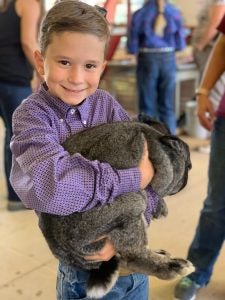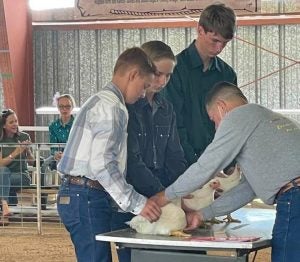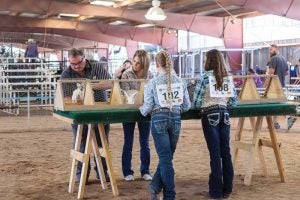Exposure to agriculture and people in the industry is key to increasing involvement in urban areas. However, livestock may seem like a low-priority project for urban youth in places where asphalt is more prevalent than farm fields. And while there’s a plethora of other exceptional projects that these organizations offer outside of raising animals for food, youth in urban areas can still experience the thrill and satisfaction that go hand-in-hand with raising and exhibiting livestock — just on a smaller, more economical scale.
4-H is the largest youth organization in the world, with over 7 million members worldwide. The first urban 4-H club was reported in Kent County, Rhode Island, in 1906. However, Rufus Stanley presumably started a program in New York some 20 years before that.
FFA, which is offered in high school and sometimes junior high, has enrolled a record number of over 850,000 members. While many FFA chapters reside in towns where agriculture is still a deep-seated part of the community, new chapters in some of the largest cities are flourishing. STEM is often the focus in urban areas, but livestock is one of the many farm-based projects that can still be brought to the city.
Broilers and bunnies are where exposure to animal agriculture can come in. These smaller livestock projects can help develop the same critical life skills as their larger counterparts while requiring fewer resources to finance and house. While inner-city youth may not have room for a steer in the backyard, many cities have bylaws and variances to ordinances that allow poultry to be kept in backyards.
Rabbits can also make an exceptional project when kept inside or outside, depending on available space and weather in the area. Just be sure to check with your local officials before diving in. These smaller livestock projects can help develop the same critical life skills as their larger counterparts by helping 4-H and FFA members to accept responsibility for something other than themselves, set goals, and raise animals as part of the food supply chain.

Poultry as a project
Meat chickens can be raised in spaces of about 2 square feet per bird. Depending on the classes offered at the county or state fair, broilers, fryers, and roasters are livestock projects especially suitable for members with limited space. Expensive housing also isn’t necessary; these chickens need only a clean, dry structure decently ventilated and safe from predators such as hawks, racoons, and coyotes.

The broiler project is also a good starter project because after ordering chicks (we’d recommend a Cornish cross), start-to-finish on raising these birds is only six to eight weeks. Meat birds can be a profitable experience, too — most shows offer sale slots for winning exhibitors. With a growing interest in locally raised food, kids can often place their live animals with someone else to process or process themselves to load up their family’s freezer. A broiler only takes about ten pounds of feed to finish per bird, and for those without access to a feed store, online retailers now offer shipment of agricultural feed.
Similar to other species of livestock, meat birds are judged based on physical defects, conformation, fleshing, uniformity, finish, and skin pigmentation. Broilers are typically shown at under six pounds and 49 days old. On the other hand, roasters are shown at under 8.5 pounds and 70 days old. Some fairs offer classes for a pen of meat birds — typically shown three at a time. Uniformity is critical here; exhibitors will choose the best, most uniform three of their flock to exhibit.
Rabbits are livestock, too
Rabbits are another exceptional livestock alternative requiring less space and financial investment than other livestock. Land requirements for this species are negligible, meat rabbits are typically affordable to purchase, and rabbits have a lower cost of gain per pound than cattle. Compared to chicken, beef, and pork, rabbit meat has fewer calories and fat per pound while packing more moisture and protein.
Cages for rabbits can be kept outdoors or indoors, but ventilation and temperature are critical. Rabbits should be housed between 45 and 70 degrees Fahrenheit. Rabbits under four pounds require less than 2 square feet of living space, but larger breeds such as Flemish giants may require up to 5 square feet of living space.

Like meat poultry, there are different market projects for rabbits. Fryers are a single-rabbit project that’s raised between eight and 10 weeks old and up to 5.5 pounds. Roasters, on the other hand, are raised to just under five months old and may weigh up to nine pounds. Stewers are raised over five months and eight pounds. The most common breeds used for meat pens are Californians and New Zealand rabbits, which are breeds specifically raised for meat production.
Some fairs offer a meat pen for rabbits class. This project includes three rabbits of the same breed and variety, raised from eight to 10 weeks old and under 5.5 pounds per rabbit. In this class, uniformity is critical — all of your rabbits should be of similar size and finish. Much like their poultry counterparts, rabbits are judged based on conformation, finish, and meat quality.
Showing meat birds or rabbits in competition can be an enjoyable, educational, and profitable experience no matter where you live. Youth participating in this project will come away with an understanding and possible experience raising livestock for meat. Before you begin, though, your best first step is to reach out to your county 4-H Extension Office or your local FFA chapter to find more information on your local fair’s classes and requirements.
Heidi Crnkovic, is the Associate Editor for AGDAILY. She is a New Mexico native with deep-seated roots in the Southwest and a passion for all things agriculture.



